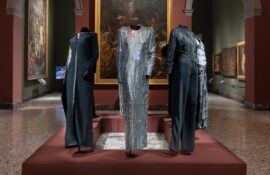Global Keynote Speaker, Futures Strategist and Bestselling Author John Sanei discusses why the successful fashion businesses of the future will be focused on intelligent, informed suggestions from brands

I perhaps surprisingly, want to talk to you about the low-cost fashion brand Shein today. Shein might not be a luxury brand, but when it comes to selling clothing, it’s doing something phenomenal as far as its business model and the way it is using technology. So I want to explain a little about how Shein runs its business and why other brands in all industries, no matter the cost of their products, should be taking note of what they are doing.
This is a new business model that to my knowledge, no other fashion brand is using and we can see how successful it is because the company is now worth $100 billion. When you compare that to Zara for example, which is worth $13.2 billion, you can understand how big the company has become. Shein has adopted a practical way to use technology to improve its brand…
For the longest time businesses have run their companies on a business model called “economies of scale.” In terms of fashion what this means is that you create a collection, you try and keep the costs low and increase your profits as much as possible and then you take out what you make. This is the way most businesses have worked for 200 years. All of a sudden, because of the developments in technology, there are opportunities for new ways of doing business. So the business model Shein is using is called “economies of learning”. To explain: if you think about what Zara does, the brand designs and creates a collection, delivers it to the stores a couple of times a week, takes products from design to stores in two weeks and add 2,000 new styles to its stores per year, that’s approximately 300 per day.
In comparison Shein is not a clothing business, rather it is a data management business. What they realised was that if they only show people what they want, it’s much easier to sell products. So they have AI and data scientists scraping the internet, looking for the clothes that are being liked and shared the most by people around the world. They will then take those clothes and computer generate ten different variations in ten different colours and put them up on their website. So a lot of what you see on the website is computer generated, and products are only made when ordered by a customer. So what they have is an opportunity to bring to their website 10,000 new styles a day! There is no comparison. But here’s the cherry on top: it costs Shein almost nothing to put online nearly 10,000 new styles a day, but it costs Zara billions and billions of dollars to put 10,000 new styles a year into their stores. Why? Because data management and AI are almost free. Once the programmes are set up there almost work on their own.
Now, when you place an order with Shein, the manufacturing is outsourced and sent to customers directly, cutting out all the costs of retail management, warehouses, transportation, and retail staff, all of that is gone! So if you think about what is happening, they are able to service the client for 70 per cent cheaper than the cheapest brands we have experienced previously, based on the fact that they don’t have a design team and they are only generating what we like. This is the difference between economies of scale and economies of learning. Economies of learning means they learn before they even make the products.l
So because of this, as a whole we need to relook at the fashion industry and the way it works because what fashion brands do is make products, put them on the shelves, market them and then hope people buy them and if not they eventually go on sale. Now what Shein is doing is creating items they already know people will like, and they are making to order which also drastically reduces waste. And the concept is completely scalable because you have thousands of outsourced manufacturers around the world, waiting to take on the world.
You may have heard the phrase “data is the new oil”. It is talking about how the currency of the future is no longer oil but data. Whoever can gather, curate and match data becomes the most powerful. And that is ultimately what Shein has done and in that sense, it is the most future-thinking fashion brand there is. The fact that they are using technology in a way that makes them incredibly profitable, and continuously on trend – because we’ve told them what we like! It’s genius!
The ironic thing is to think that a brand that is selling such low-priced clothing is so far ahead of anyone else. So I ask luxury brands to take note: they should be running all of their businesses like this, of course in more niche or slimmed-down ways, but I truly believe it is the future.
Now the reason why this has worked so well is that companies need today and tomorrow teams. Your today team focuses on what you’re doing now and the tomorrow team is experimenting and imagining for the future. So all brands, no matter how small or how big MUST have today and tomorrow teams, you cannot ask the same people to do both.
So as we move forward expect more intelligent data management and more personalised data management and these will be the businesses that succeed moving forward. It is just a matter of time before everything in our lives becomes intelligent suggestive machines. The reason Netflix is losing market share is not because of the lack of content but because of the lack of suggestions. People today want things to be easy and fast and in a sense handed to them on a plate without having too much choice, and these are the companies that will succeed in every sector.
By John Sanei















